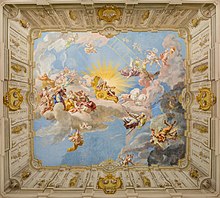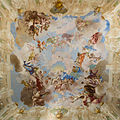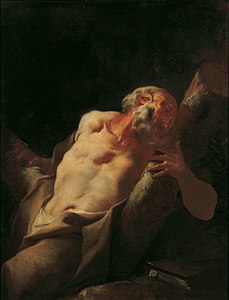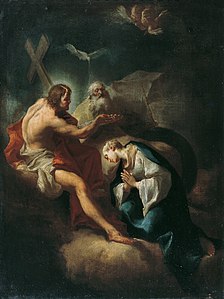Paul Troger

Paul Troger (born October 30, 1698 in Welsberg , Pustertal , South Tyrol , † July 20, 1762 in Vienna ) was one of the most important Austrian painters of the Baroque .
Life
The Bishop of Gurk , Jakob Maximilian von Thun and Hohenstein , made it possible for him to go on a longer study trip to Italy around 1720 , where he studied with Giambattista Piazzetta in Venice and Francesco Solimena in Naples , among others .
In 1727/28 he created his first major work, the high altar picture and the dome fresco of the Kajetan Church in Salzburg . He then settled in Vienna, where painting, however, was dominated by Johann Michael Rottmayr and Daniel Gran , so that he moved to Lower Austria . He created most of his frescoes in the monasteries of Lower Austria, often working with his Tyrolean compatriots such as the architect Joseph Munggenast and the painter Johann Jakob Zeiller .
His last major work are the ceiling frescoes of the Brixen Cathedral , which are painted in an expressive, forward-looking style (1748/50). In the last years of his life he only created easel paintings.
Paul Troger was by far the most important teacher among the Austrian painters of the 18th century. In addition to Johann Jakob Zeiller, his students include the Tyrolean Martin Knoller , Franz Anton Leitenstorffer , Pietro Antonio Lorenzoni , Josef Ignaz Mildorfer and Franz Zoller , the Bohemians Johann Baptist Wenzel Bergl and Franz Xaver Wagenschön and the Viennese Stephan Dorfmeister and Josef Hauzinger .
From 1754 to 1757 Troger was rector of the Vienna Academy of Fine Arts .
Troger used light and color specifically for allegorical purposes; there is almost always a “light” and a “dark” side in his pictures. Often it is also the allegorical figures that function as a “source of light”, which also raises perspective problems. Compared to the classically oriented Gran, there is an increase in expressiveness in Troger, which was even stronger in his successor Franz Anton Maulbertsch . Oskar Kokoschka consciously placed himself in the traditional line of Troger-Maulbertsch.
In 1894, Trogergasse in Vienna- Penzing (14th district) was named after him.
His grave is in the Schottenkirche (Vienna) .
Works
Ceiling frescoes:
- Kajetan Church : Dome fresco Heavenly Glory of St. Kajetan , 1728
- Melk Abbey : ceiling frescoes in the marble hall and library, 1731/32; in the reception room of the prelature, 1739 (not open to the public); in the Kolomanisaal with the depiction of the history of Melk Abbey, 1745 (accessible during concerts)
- Zwettl Abbey : Ceiling frescoes in the library with topics relating to monastic education, 1733
- Altenburg Abbey : Dome fresco of the collegiate church: an interpretation of the Apocalypse of St. John, which is one of the most important Baroque frescoes in Central Europe, 1733
- Seitenstetten Abbey : ceiling fresco of the marble hall, 1735
- Geras Abbey : ceiling fresco of the marble hall (former summer refectory): Wonderful bread multiplication , 1738
- Göttweig Abbey : ceiling fresco of the Kaiserstiege: Apotheosis of Charles VI. , who is depicted as the sun god Apollo , 1739
- Seitenstetten Abbey: ceiling fresco of the library, 1741
- Altenburg Abbey: Library: three dome frescoes with allegorical personifications and scenic examples; on the middle fresco the personification of divine wisdom and the scene of the visit of the Queen of Sheba to King Solomon , 1742
- Bressanone Cathedral : cycle of frescoes consisting of the adoration of the lamb (based on the Revelation of John ) in the nave, the angelic concert above the organ, the Assumption of Mary in the presbytery above the high altar, as well as Saint Kassian as teacher and messenger of faith in both Arms of the transept. Another fresco, the false dome in the crossing , was destroyed in 1895. These frescoes are the only ones that Troger created in his Tyrolean homeland. They were created in 1748–50.
- Basilica Maria Dreieichen bei Horn: main dome fresco, 1752
Photos:
- Kajetanerkirche : side altarpiece of St. Cajetan as Comforter for the Plague , 1735
- Bürgerspitalkirche St. Blasius : Altarpiece Adoration of the Three Kings , 1746
- Salzburg City Hall : Images of Justice in the Assembly Hall , 1749
Altarpieces:
- Kajetanerkirche : high altar picture St. Maximilian , 1727
- Welsberg , parish church of St. Margaret: high altar picture with St. Margaret and other saints; Side altar paintings of the Adoration of the Magi (dated 1737) and the alms giving of St. John Nepomuk
- Vienna, Schönbrunn Palace Chapel : high altar painting of the Marriage of Mariae , approx. 1744
- Salzburg, Bürgerspitalkirche St. Blasius : side altarpiece of the Adoration of the Three Kings , 1746
- Dommelstadl (Lower Bavaria), Holy Trinity Parish Church : Holy Trinity high altar painting , 1752
- Zistersdorf , Maria Moos pilgrimage church: high altar painting of Mary in Heaven , 1753
painting
- St. Penitent (King Manasse, St. Wilhelm, Maria from Magdala, Maria of Egypt), cycle of pictures in the Kajetan Church
- Joachim and Anna , around 1730, oil on canvas, 123 × 97 cm, Belvedere , Vienna
- The wonderful multiplication of bread , around 1731, oil on canvas, 64 × 95 cm, Belvedere , Vienna
- The birth of Christ, around 1735, oil on canvas, Bischöfliches Palais, Klagenfurt
- Saint Bernard of Clairvaux, around 1735, oil on canvas, Bischöfliches Palais, Klagenfurt
- The Apostle Andreas , around 1738, oil on canvas, 123 × 93 cm, Belvedere , Vienna
- Allegory of the Immaculate Conception of Mariae , around 1740/1750, oil on canvas, 51 × 53 cm, Belvedere , Vienna
- St. Joseph, around 1740, Basilica Maria Loreto, St. Andrä im Lavanttal
- The fall of the magician Simon , around 1743, oil on canvas, 75.5 × 51.5 cm, Belvedere , Vienna
- Saint Sebastian and the women , around 1746, oil on canvas, 60 × 37 cm, Belvedere , Vienna
- The Annunciation to Maria , around 1747, oil on canvas, 85.5 × 52 cm, Belvedere , Vienna
- The Adoration of the Lamb by the 24 Elders , around 1748/1750, oil on canvas, 101 × 64 cm, Belvedere , Vienna
- Saint Xavier among the plague sufferers in Goa , around 1749/1750, oil on canvas, 75 × 60 cm, Belvedere , Vienna
- Christ on the Mount of Olives , around 1750, oil on canvas, 241 × 157 cm, Belvedere , Vienna
- Moses brings the Law from Mount Sinai , around 1750, oil grisaille on paper, mounted on cardboard, 43 × 31 cm, Belvedere , Vienna
- Maria with the child , around 1750/1760 (?), Oil on canvas, 51 × 41 cm, Belvedere , Vienna
- The torture of St. Cassian , around 1751/1753, oil on canvas, 75 × 45 cm, Belvedere , Vienna
- Coronation of Mary , around 1760, oil on canvas, 100 × 74 cm, Belvedere , Vienna
- Works by Paul Troger in the Belvedere
literature
- Hermann Arthur Lier : Troger, Paul . In: Allgemeine Deutsche Biographie (ADB). Volume 38, Duncker & Humblot, Leipzig 1894, p. 633 f.
- Aschenbrenner, W./Schweighofer, G .; Paul Troger. Life and Work, Salzburg (1965), Verlag St. Peter
- Entry about Lorenzi, Peter Anton on Artisti Italiani in Austria , a project of the University of Innsbruck
- On the 250th anniversary of the death of the baroque painter Paul Troger, special edition of the magazine “Der Schlern”, July / August 2012 (with essays by Leo Andergassen, Andreas Gamerith and Cornelia Plieger, Rudolf Ingruber, Elvio Mich, Klaus Steinmair, Werner Telesko , Hanns-Paul Ties )
- Johann Kronbichler: Paul Troger (1698-1762). Deutscher Kunstverlag, Berlin / Munich 2012. ISBN 978-3-422-07127-8
- Altenburg Abbey: Paul Troger & Altenburg. Altenburg Abbey, Altenburg (no year, 2012 or later)
Web links
- Entry on Paul Troger in the database of the state's memory for the history of the state of Lower Austria ( Museum Niederösterreich )
- Literature by and about Paul Troger in the catalog of the German National Library
- Works by Paul Troger at Zeno.org .
- Works by Paul Troger In: Digitales Belvedere
| personal data | |
|---|---|
| SURNAME | Troger, Paul |
| BRIEF DESCRIPTION | Austrian Rococo painter |
| DATE OF BIRTH | October 30, 1698 |
| PLACE OF BIRTH | Monguelfo , Pustertal , South Tyrol |
| DATE OF DEATH | July 20, 1762 |
| Place of death | Vienna |
































